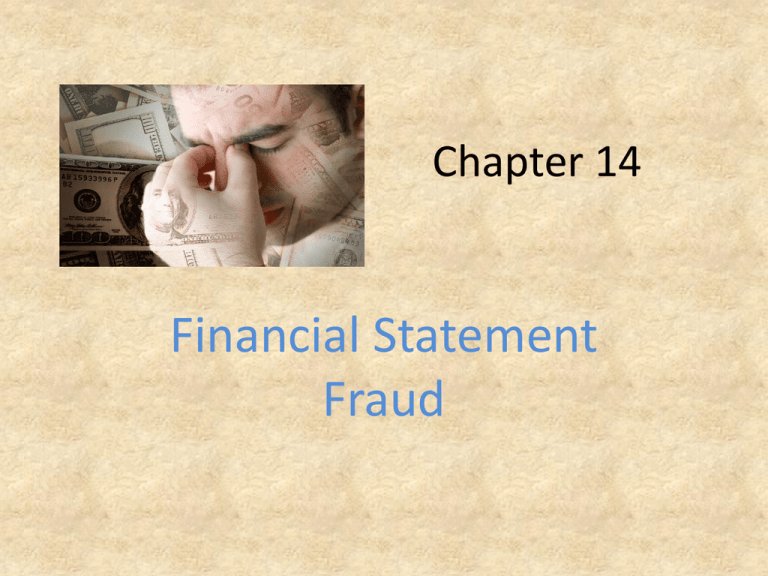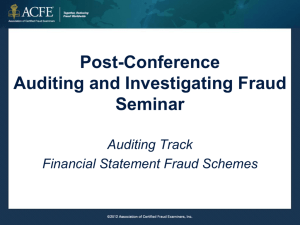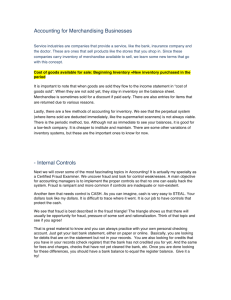Chapter 14
advertisement

Chapter 14 Financial Statement Fraud Critical Thinking Exercise A woman shoots her husband. Then she holds him under water for over 5 minutes. Finally, she hangs him. But 5 minutes later they both go out together and enjoy a wonderful dinner together. How can this be? Fraud in Financial Statements • Pressure on upper management to show earnings • Subjective nature of the way books and records are kept • Three general questions that go to the heart of these crimes – Who commits financial statement fraud? – Why do people commit financial statement fraud? – How do people commit financial statement fraud? Who Commits Financial Statement Fraud? Three main groups of people commit financial statement fraud – Senior management – Mid and lower-level employees – Organized criminals Why Do People Commit Financial Statement Fraud Senior managers and business owners may “cook the books” for several reasons – To conceal true business performance – To preserve personal status/control – To maintain personal income/wealth How Do People Commit Financial Statement Fraud? Three general ways in which fraudulent financial statements can be produced: 1. Playing the accounting system 2. Beating the accounting system 3. Going outside the accounting system NOTE: Commonly starts with the first method and progressively incorporates the other two methods Conceptual Framework for Financial Reporting I. Recognition and Measurement Concepts A. Assumptions • • • • i. Economic entity ii. Going concern iii. Monetary unit iv. Periodicity B. Principles • • • • i. Historical cost (Fair value) ii. Revenue recognition iii. Matching Expenses to Revenues iv. Full disclosure C. Constraints • • • • i. Cost-benefit ii. Materiality iii. Industry practice iv. Conservatism II. Qualitative Characteristics A. Relevance and Reliability B. Comparability and Consistency Responsibility for Financial Statements • Company management is responsible • Board of directors and senior management set the organization’s “culture” – “Tone at the Top” – High integrity leads to more honest employees Users of Financial Statements • Potential users of financial statements – Company’s owners – Lending organizations – Vendors / Customers – Investors • Uses of financial statements – Increase the apparent prosperity of the organization – Dispel negative perceptions – Judge employee or management performance Types of Financial Statements • Statement on Auditing Standards (SAS) No. 62 • Types of financial statements – – – – – – – – – – Balance sheet Statement of income or statement of operations Statement of retained earnings Statement of cash flows Statement of changes in owners’ equity Statement of assets and liabilities that does not include owners’ equity accounts Statement of revenue and expenses Summary of operations Statement of operations by product lines Statement of cash receipts and disbursements Types of Financial Statements • Other financial data presentation – Prospective financial information – Pro forma financial statements – Proxy statements – Interim financial information – Current value financial representations • Other comprehensive bases of accounting – Government or regulatory agency accounting – Tax basis accounting * The term financial statement includes almost any financial data presentation Case Study: That Way Lies Madness Eddie Antar’s 7-Point Plan 1. Listed smuggled money from foreign banks as sales 2. Made false entries to accounts payable 3. Overstated Crazy Eddie, Inc.’s inventory by breaking into and altering audit records 4. Took credit for “returning” merchandise while continuing to count it as inventory 5. “Shared inventory” from one store to another to boost stores’ audit counts 6. Arranged for vendors to ship merchandise and defer the billing 7. Sold large lots of merchandise to wholesalers, then spread the money to individual stores as retail receipts Fraudster’s Perspective • Hide your dirty laundry in the footnotes – Prior to 1987: Purchase discounts and trade allowances are recognized when received – In fiscal year 1987: Purchase discounts and trade allowances are recognized when earned – No disclosure was made as auditors ignored the effects of the accounting change – Obstruction by distraction • Lessons from the Crazy Eddie accounts payable fraud – – – – Even sophisticated investors don’t read footnotes Audit was poorly planned, executed, and supervised Crazy Eddie had weak internal controls Auditors were too trusting Types of Fraudulent Financial Statement Schemes Five distinct categories: – Fictitious revenues – Timing differences – Concealed liabilities and expenses – Improper disclosures – Improper asset valuation Defining Financial Statement Fraud • Deliberate misstatements or omissions of amounts or disclosures of financial statements to deceive financial statement users, particularly investors and creditors • Statement on Auditing Standards (SAS) No.99 “Consideration of Fraud in a Financial Statement Audit” – Misstatements arising from fraudulent financial reporting – Misstatements arising from misappropriation of assets Defining Financial Statement Fraud • Financial statement fraud may involve the following schemes – Falsification, alteration, or manipulation of material financial records, supporting documents, or business transactions – Material intentional omissions or misrepresentations of events, transactions, accounts, or other significant information from which financial statements are prepared – Deliberate misapplication of accounting principles, policies, and procedures used to measure, recognize, report, and disclose economic events and business transactions – Intentional omissions of disclosures or presentation of inadequate disclosures regarding accounting principles and polices and related financial amounts Costs of Financial Statement Fraud 1. Undermines the reliability, quality, transparency, and integrity of the financial reporting process 2. Jeopardizes the integrity and objectivity of the auditing profession 3. Diminishes the confidence of the capital markets in reliability of financial information 4. Makes the capital markets less efficient 5. Adversely affects the nation’s economic growth and prosperity 6. Results in huge litigation costs Costs of Financial Statement Fraud 7. Destroys careers of individuals involved in financial statement fraud 8. Causes bankruptcy or substantial economic losses by the company engaged in financial statement fraud 9. Encourages regulatory intervention 10. Causes devastation in the normal operations and performance of alleged companies 11. Raises serious doubt about the efficacy of financial statement audits 12. Erodes public confidence and trust in the accounting and auditing profession Fictitious Revenues • Recording of sales of goods or services that did not occur • Artificially inflate or alter invoices of legitimate customers • Revenue is recognized when 1. Realized or realizable 2. Earned • All the following criteria must be met – – – – Persuasive evidence of an arrangement exists Delivery has occurred or services have been rendered The seller’s price to the buyer is fixed or determinable Collectability is reasonably assured Fictitious Revenues • Current conceptual guidelines for revenue recognition – FASB Concepts Statement No. 5 “Recognition and Measurement in Financial Statements of Business Enterprises” – FASB Concepts Statement No. 6 “Elements of Financial Statements” • FASB and IASB have partnered to tackle issue of revenue recognition Sales with Conditions • Sale is booked even though – Some terms have not been completed – The rights and risks of ownership have not passed to the purchaser • Recorded in an effort to fraudulently boost a company’s revenue • Do not qualify for recording as revenue until conditions are satisfied Pressures to Boost Revenues • External pressures to succeed often provide motivation to commit fraud – Loan requirements by banks • Pressures to commit financial fraud may also be internal – Departmental budget requirements Red Flags Associated with Fictitious Revenues • Rapid growth or unusual profitability • Inability to generate cash flows from operations while reporting earnings • Significant transactions with related parties or specialpurpose entities not in the ordinary course of business • Significant, unusual, or highly complex transactions • Unusual growth in the number of days’ sales in receivables • A significant volume of sales to entities whose substance and ownership is not known • Unusual surge in sales by a minority of units within a company Timing Differences • Recording of revenues and/or expenses in improper periods • Shift revenues or expenses between one period and the next – Increase or decrease earnings as desired Matching Revenues with Expenses • Revenues and corresponding expenses should be matched in the same accounting period – Failure to do so violates GAAP’s matching principle • Record revenue in December and expense in January to overstate net income at year end Premature Revenue Recognition • Early recognition of revenue can serve as a catalyst to further fraud • One or more of the criteria set forth in SEC Staff Bulletin No. 104 are typically not met – Persuasive evidence of an arrangement does not exist – Delivery has not occurred or services have not been rendered – The seller’s price to the buyer is not fixed or determinable – Collectability is not reasonably assured Long-Term Contracts • Completed contract method – Does not record revenue until completion of the project is 100% complete – Construction costs are held in an inventory account until completion of the project • Percentage of completion method – Recognizes revenues and expenses as measurable progress on a project is made – Vulnerable to manipulation – Used to prematurely recognize revenues and conceal contract overruns Channel Stuffing • “Trade loading” • Sale of unusually large quantity of a product to distributors – Encouraged to overbuy through the use of deep discounts and/or extended payment terms • Attractive in industries with high gross margins • Steals from next period’s sales • Raises questions about collectability of accounts receivable Recording Expenses in the Wrong Period • Timely recording of expenses is often compromised – Pressures to meet budget projections and goals • Not properly matched against the income that they help produce Red Flags Associated with Timing Differences • Rapid growth or unusual profitability compared to other companies in the industry • Inability to generate cash flows from operations while reporting earnings • Significant, unusual, or highly complex transactions • Unusual increase in gross margin or margin in excess of industry peers • Unusual growth in the number of days’ sales in receivables • Unusual decline in the number of days’ purchases in accounts payable Concealed Liabilities and Expenses • Significant impact on reported earnings • Easier to commit than falsifying sales transactions • 3 common methods for concealing liabilities and expenses – Liability/expense omissions – Capitalized expenses – Failure to disclose warranty costs and liabilities Liability/Expense Omissions • Easiest method of concealing liabilities/expenses • Among the most difficult financial statement schemes to uncover • Perpetrators often believe they can conceal their fraud in future periods • Adelphia Capitalized Expenses • Costs that provide a benefit to a company over more than one accounting period • Overstate income in current period, understate income in subsequent periods • WorldCom • Expensing capital expenditures – Minimize income in current year for tax considerations – Increase income in future periods Returns and Allowances and Warranties • Expense associated with sales returns and customer allowances • Record expense as contra-sales account – Reduce amount of net sales • Estimated warranty expense should be accrued as liability Red Flags Associated with Concealed Liabilities and Expenses • Inability to generate cash flows from operations while earnings growth • Assets, liabilities, revenues, or expenses that involve subjective judgments that are difficult to corroborate • Nonfinancial management’s excessive participation in selection of accounting principles or determination of significant estimates • Unusual increase in gross margins in excess of industry peers • Allowances for sales returns and warranty claims that are out of line with industry peers • Unusual reduction in the number of days’ purchases in accounts payable • Reducing accounts payable while competitors are stretching out payments to vendors Improper Disclosures • Disclosures are supposed to prevent user of financial statements from being misled • Improper disclosures relating to financial statement fraud – Liability omissions – Subsequent events – Management fraud – Related-party transactions – Accounting changes Liability Omissions • Failure to disclose loan covenants – Agreements that borrower has promised to keep as long as financing is in place – Ratio limits or restrictions on other financial agreements • Failure to disclose contingent liabilities – Potential liabilities that will materialize only if certain events occur in the future Subsequent Events • Events occurring or becoming known that may have significant effect on financial statements • Should be disclosed • Fraudsters often avoid disclosing court judgments • Public record searches often reveal this information Management Fraud • Must disclose fraud committed by officers, executives, and others in position of trust • Withholding such information likely involves lying to auditors, an illegal act Related-Party Transactions • Business with entity that is significantly influenced by company • “Self-dealing” • Legal as long as they are fully disclosed • Arm’s length • Tyco Accounting Changes • Statement of Financial Accounting Standards No. 154 (SFAS 154) “Accounting Changes and Error Corrections” – Accounting principles – Estimates – Reporting entities • Fraudster may not restate if change causes financial statements to appear weaker Red Flags Associated with Improper Disclosures • Domination of management by a single person without compensating controls • Ineffective board of directors or audit committee oversight • Significant related-party transactions not in ordinary course of business • Overly complex organizational structure • Recurring attempts by management to justify marginal or inappropriate accounting • Restrictions on the auditor that limit access to people or information Improper Asset Valuation • Misclassification of long-term assets as current assets – “Window dressing” • Improper asset valuation categories – Inventory valuation – Accounts receivable – Business combinations – Fixed assets Inventory Valuation • “Lower of cost or market value” • Manipulation of physical inventory count • Inflation of unit costs used to price out inventory • Failing to relieve inventory for costs of goods sold • Phantom inventory Accounts Receivable • Should be reported as net realizable value • Fictitious accounts receivable – Common at end of accounting period – False confirmations of balances to auditors • Failure to write down – Required to accrue losses on uncollectable receivables • Financial Accounting Standards Board Statement No. 5 – Record impairment of long-lived assets and goodwill • Statement of Financial Accounting Standards No. 144 • Statement of Financial Accounting Standards No. 142 Business Combinations • Required to allocate purchase price to tangible and intangible assets • Changes in goodwill accounting • Companies still may be tempted to – over-allocate purchase price to in-process R&D assets – Establish excessive reserves for various expenses to release at a future date Fixed Assets Common fixed asset schemes – Booking fictitious assets – Misrepresenting asset valuation – Understating assets – Capitalizing non-asset cost – Misclassifying assets Red Flags Associated with Improper Asset Valuation • Inability to generate cash flows from operations earnings growth • Significant declines in customer demand and increasing business failures • Unusual change in the relationship between fixed assets and depreciation • Adding to assets while competitors are reducing capital tied up in assets • Allowances for bad debts, excess and obsolete inventory that are out of line with industry Detection of Fraudulent Financial Statement Schemes • Financial statement analysis – Vertical analysis (percentage analysis) • Analyze relationships between items on income statement, balance sheet, or statement of cash flows – Horizontal analysis (percentage analysis) • Analyze percentage change in individual financial statement items from one year to the next – Ratio analysis • Measure relationship between 2 different financial statement amounts Deterrence of Financial Statement Fraud • More complex than deterring asset misappropriation and other frauds • 83% of financial statement frauds involved CEO or CFO • Executives use their authority to override most internal controls Reduce Pressure to Commit Financial Statement Fraud • Establish effective board oversight of the “tone at the top” created by management • Avoid setting unachievable or unreasonable goals • Avoid applying excessive pressure on employees to achieve goals • Change goals if changed market conditions require it • Ensure compensation systems are fair and do not create too much incentive to commit fraud • Discourage excessive external expectations of future corporate performance • Remove operational obstacles blocking effective performance Reduce the Opportunity to Commit Financial Statement Fraud • Maintain accurate and complete internal accounting records • Carefully monitor business transactions and interpersonal relationships between financial units • Establish a physical security system to secure company assets • Divide important functions among employees • Encourage strong supervisory and leadership relationships to enforce accounting procedures • Establish clear and uniform accounting procedures with no exception clauses Reduce Rationalization of Financial Statement Fraud • Promote strong values throughout the organization • Clearly define prohibited behavior • Provide regular training to all employees communicating prohibited behavior • Have confidential advice and reporting mechanisms • Communicate that integrity takes priority over goals • Ensure management practices what it preaches • The consequences of violating the rules and punishment of violators should be clearly communicated






